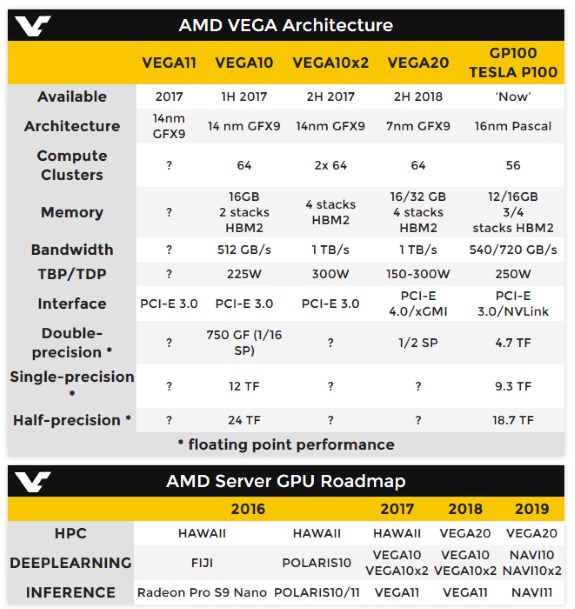
2016: Radeon Pro S9 Nano
Even though the consumer-level Fiji GPUs are already end-of-life, AMD thinks there's room in the professional market for a Radeon Pro S9 Nano. This card is expected to launch in a couple of weeks, the exact specifications are unknown but it's likely very similar to the Radeon R9 Nano.
2017: Vega10 and dual-GPU Vega10
Next year we can expect the launch of AMD's first Vega based video cards. For the professional market, this will include the Vega10 with 64 CUs, 16GB HBM2, 512GB/s memory bandwidth, 225W TDP, 750 gigaflops of double-precision, 12 teraflops of single-precision and 24 teraflops of half-precision computing power. As you can see, the double-precision performance is pretty poor (just 1/16 of SP) so this is the reason why AMD will continue to sell professional Hawaii-based video cards in 2017.
Vega10 arrives in the first half of the year and a double-GPU Vega10x2 is expected in the second half of 2017. This model has a 300W TDP and features 2x 64 CUs, four stacks HBM2 with a bandwidth of 1TB/s. Just like the single-GPU version, this chip is made on a 14nm process.
2018: Vega20 on a 7nm process?
Things got a bit confusing yesterday with the claim that Vega20 would launch on a 7nm process. We know GlobalFoundries isn't expected to kick off 7nm risk production until 2018 but now it appears this Vega20 GPU isn't planned until the second half of 2018. A launch toward the end of 2018 could be plausible but only if nothing goes wrong at GlobalFoundries. And that's a big if!
Vega20 appears to be a rival for NVIDIA's high-end compute GPUs, which are used for the flagship Tesla and Titan cards. The Vega20 chip reportedly sticks to 64 CUs but promises a double-precision floating point performance that's roughly half the level of its single-precision performance. This ratio is comparable to the NVIDIA GP100 and a big improvement versus the 1:16 ratio offered by the Vega10.
In the 2018 timeframe, we may also see the launch of xGMI, which is a peer-to-peer GPU communication system from AMD. This NVIDIA NVLink competitor is expected to become available with the Zen-based Naples SoC sometime in the second half of 2018.
2019: Launch of the Navi GPU
The first professional cards based on Navi are expected in the 2019 timeframe. The Navi11 will replace the lower-end Vega11 parts, while Navi10 and Navi10x2 will replace the Vega10 and Vega10x2 models. Navi will not replace the Vega20.
